Core i7 Entry
With the i7 processors at the top of every performance comparison, many readers are interested in building a new Core i7 system. However, much of the i7 architecture is unique compared to current computer architectures, with a new socket 1366 and triple-channel DDR3 memory. That means i7 buyers will likely be buying more components than normal for the move to i7. In fact it is not unreasonable to expect a complete new system build, or at least the bulk of a complete system build, when you decide to move up to Core i7.
The question then is what is the absolute minimum you can spend and still get into a decent performing i7 system? In our System Buyers Guide: $1000 to $2000 a balanced i7 system with the cheapest Core i7 CPU managed to squeeze in at just under $2000. In the short time since that guide was published many prices have dropped, new drivers are available, and there are more options available for a Core i7 system. The goal is also a bit more modest in this Core i7 Entry system. The task was to put together a complete i7 system at near bare bones pricing.
In almost every category a lower performing and lower priced option is possible, but it makes little sense to build an i7 system and saddle it with last generation's midrange video card for example. For that reason the video choice was a Radeon 4870 1GB, which many consider the minimum for a serious gaming rig. Where the lower-priced options make just a small difference in performance we chose lower price, but where it really mattered in total system performance the better performing choice was made.
| Core i7 Entry PC | ||
| Hardware | Component | Price |
| Processor | Intel Core i7 920 Socket 1366 (2.66GHz Quad-core, 4x256KB L2, 8MB L3 Cache) |
$295 |
| Cooling | Intel Retail HSF | - |
| Video | MSI R4870-T2D1G Radeon HD 4870 1GB | $205 |
| Motherboard | GIGABYTE GA-EX58-UD3R X58 | $185 |
| Memory | Patriot Viper 3GB (3x1GB) DDR3-1333 (PC3-10666) PVT33G1333ELK - Retail | $70 |
| Hard Drive | Samsung Spinpoint F1 HD103UJ 1TB | $95 |
| Optical Drive | LG BD/HD DVD / 16x DVD+/- RW GGC-H20LK | $105 |
| Audio | On-Board Audio | - |
| Case | COOLER MASTER Centurion 534 RC-534-SKN2-GP ATX Mid-Tower | $50 |
| Power Supply | OCZ StealthXStream OCZ700SXS 700W SLI Ready CrossFire Ready | $70 |
| Display | Acer H213Hbmid 21.5" 5ms HDMI 1080P LCD - Retail | $190 |
| Speakers | Creative Inspire T6100 76W 5.1 Speakers | $70 |
| Input | Microsoft CA9-00001 Black PS/2 Keyboard and Optical USB/PS2 Mouse - OEM | $16 |
| Operating System | Microsoft Vista Home Premium OEM | $99 |
| Bottom Line | $1450 | |
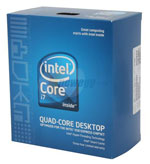 |
The i7 920 is the lowest priced Intel Core i7 you can currently buy. The other two choices are in the $600 to $1000 price range. Don't assume, however, that the 920 is not a powerful processor. The i7 920 is 30% faster in some tests than a Core 2 Quad, and then you find you can also overclock this 2.66GHz CPU to 3.6GHz to 4GHz with careful tweaking and better cooling. You will certainly be very happy with Core i7 base performance, but if you are interested in overclocking you will be even happier with this new CPU.
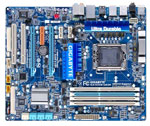 |
The Gigabyte GA-EX58-UD3R has the distinction of being the lowest priced X58 chipset motherboard you can currently buy. Others will join that sub-$200 price point soon to provide more X58 value choices. You probably also noticed that Gigabyte is trying to get as much mileage as possible from their UD3R designation, holding on to a good name as much as possible.
Since this system goal is the lowest priced Core i7 system, we stuck with the retail Intel HSF that comes with the CPU. It works fine with the Core i7 at stock speeds, even though it runs hotter than a similar Intel HSF on Core 2 chips. In the past an Intel retail HSF would be a guarantee of at least midrange overclocking, but the Core i7 runs hotter and you will not get much of an overclock with the Intel HSF. If you plan to overclock you will definitely need a third party HSF, like the Vigor Monsoon III or the Thermalright Ultra-120 eXtreme-1366.
In the Core i7 System in the $1000 to $2000 System Guide, the problems with ATI drivers on Core i7 were discussed. Since then driver releases from ATI are going in the right direction. There is also the price difference, with the capable 4870 1GB some $120 less than the now lower-priced NVIDIA GTX 280. There is also the fact that the Gigabyte GA-EX58-UD3R supports only CrossFire for multiple GPUs.
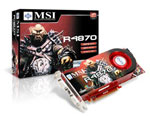 |
Put all those pieces together and the choice for GPU on the i7 Entry system is the Radeon 4870 1 GB. The best value today is the MSI R4870-T2D1G, which is just $205 after a $25 rebate. The best value in HD 4870 1GB cards shifts day-by-day, but you can generally shop for the lowest price on a 4870 1GB card and end up with a good quality card.
 |
Triple-channel memory comes in a 3GB kit (3x1GB) or a 6GB kit (3x2GB). Value dictates the 3GB choice with a great memory package from Patriot. The Viper DDR3-1333 comes as a 3GB kit won't break the bank at $70. For just $70 more, you can upgrade to a 6GB DDR3-1333 kit instead.
Good cases and power supplies are either used forever or they go with the old board on a system upgrade. Generally, it's best to invest in the best case and power supply you can afford. Since this is an Entry i7 we can cut costs on the case and PSU, and with numerous price cuts and rebates available on these components you can still get a lot of value for just a little money.
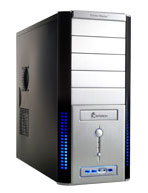 |
The Cooler Master Centurion 534 is a good value no matter how you look at it. It does come in different configurations, and the RC-534-SKN2-GP case is a good choice since it comes with three 120mm fans (front, side, and back) for cooling and installation requires no tools other than a screwdriver for mounting the motherboard. There are also plenty of drive bay options with five external 5.25" bays, one external 3.5", and four internal 3.5". Front USB/Firewire/Audio connectors are also featured. Builders report smooth edges and no sharp pieces to cut your hand during assembly. Even the expansion slots are screwless in this design. Our selection at $50 is black with a brushed aluminum and mesh front, but the case is also available in all black if you prefer at $55.
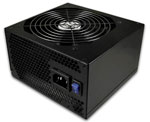 |
The power supply is an excellent value at $70. That $70 buys a 700W OCZ StealthXStream after a $20 rebate. This OCZ PSU specifies an efficiency of greater than 85% with both overload and overvoltage protection. The OCZ StealthXStream 700W should be able to handle whatever you ask of it in powering or overclocking a more basic Core i7 920 system.
 |
Hard drive capacity continues to grow, as you can see in our selection of the Samsung SpinPoint 1TB (1000GB) hard drive at just $95. For less than $100 the value is incredible. While there are differences between hard drives, outside of running benchmarks most people aren't likely to notice the difference in performance between Western Digital, Seagate, Samsung, Hitachi, and other major brands. All are worthy of consideration if the price per gigabyte (or terabyte) is right.
 |
The optical drive for an entry Core i7 system needs to play Blu-ray disks. The flexible LG GGC-H20LK has the ability to read both Blu-ray and HD-DVD format disks. It also can burn DVDs at 16x speed in single or dual-layer formats. It cannot, however, burn 25GB/50GB Blu-ray disks; adding that capability raises the cost to around $200. A BD burner like the LG 6X Blu-ray Burner GGW-H20LK is a good choice if you require a Blu-ray burner.
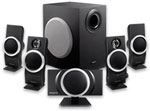 |
After reviewing the current state of onboard audio, we concluded that the onboard solutions are plenty adequate for most of today's computer users. That is why we stuck with the onboard audio on the Gigabyte. Speakers are the 5.1 Creative Inspire T6100 76W system. At $70 the T6100 delivers very good 5.1 surround sound for the price.
 |
The LCD display resolution for the Entry Core i7 system is 1080p full HD (1920x1080). The monitor is one of the new class of 21.5" monitors with a resolution the same as last generation's 24" LCD monitors. The newest monitors use a 16:9 "true HD" ratio instead of last generation's 16:10. The resolution is the same as 24" monitors, but the price is a bargain at $190, which saves at least $100. The Acer H213Hbmid monitor is rated at 5ms and features HDMI inputs for easy hookup to the latest video cards like the MSI Radeon 4870 1GB used in this entry Core i7 system.
By paring components to the items that most affected performance, the bottom line price for a complete Core i7 is cut by more than 25% from our choices of just a few weeks ago. This reduces the price of entry for a complete i7 system to $1450 including a 1080p LCD Monitor, keyboard/mouse, 5.1 speakers, Blu-ray player, 1TB drive, Radeon 4870 1GB graphics, and Windows Vista OS. Performance of this i7 Entry system is definitely in the high-end class, although we will be extending that performance even further in our builds of the Core i7 Overclocking System, and Core i7 Dream system.










106 Comments
View All Comments
Burrich - Friday, February 6, 2009 - link
If I was to configure a system for overclocking or a "dream system", performance would be my highest priority. Why does this review stop short of offering items like RAID0 or RAID5?Considering that you're using the X58 chipset, including the ICH10R southbridge, why aren't you exploring the Intel Matrix RAID solution? With two disks you can set up a RAID0 and RAID1 array. Sure, it might not currently be extremely flexible (and may not be for everyone), but it can be a very good solution for someone with 2 1TB drives that are interested in both performance and redundancy.
JarredWalton - Friday, February 6, 2009 - link
Since I'm in the midst of dealing with a RAID disaster, let me just say that I'm not fully convinced that I will never bother with onboard RAID solutions ever again. My motherboard crapped out on me, and thus until I can get a new board with the appropriate controller, I can't get at my data. Since the board is two years old, I need to find something with ICH7R - easier said than done. Obviously, that's not an issue if you have a RAID card, but I'm totally done with RAID0 going forward! It may be slightly higher performance, but it's also high risk. I'd much rather have two separate drives these days.JarredWalton - Friday, February 6, 2009 - link
Erm... "I'm fully convinced that I will never bother..."7Enigma - Friday, February 6, 2009 - link
Does the Asus Revolution not support the Thermalright Ultra120 Extreme? I don't know why this wouldn't have been selected instead, other than the Dream System is not meant to be OC'd or an incompatibility due to the size of the Ultra120?The Vigor Monsoon to my best ablility doesn't even show up in your cpu cooling reviews. Is it another cooler (like the Xigmatek Rifle 120) that you tested but never released results for?
Wesley Fink - Monday, February 9, 2009 - link
Anand, Gary Key, and I have all three used the Vigor Monsoon III to cool an i7 system with good results. The Thermalright Ultra 120 eXtreme-1366 only recently was available as a Socket 1366 kit. Both have done well in cooling a Core i7 system, and both will fit the Asus board used in the dream system. The Monsoon II and Thermalright have both been very good performers in early testing.We have not added to our cooler testing in a while, but we are working on new cooler tests for Socket 1366. This is mostly because the stock 1366 cooler barely goes beyond rated speed and does not provide the reserve of past stock cooling from Intel.
bijeshn - Friday, February 6, 2009 - link
another howler:Intel Core i7 965 Socket 1366
(3.2GHz Quad-core, 4x256MB L2, 8MB L3 Cache)
4x256 MB?!!
Wesley Fink - Friday, February 6, 2009 - link
Sorry for the typo - now corrected. The first two table listings were correct at 256kbx4 L2, but the third table entry, as you pointed out, stated 256MB instead of 256kb.Lots of things must make you laugh if this typo has you howling with laughter :)
Doormat - Thursday, February 5, 2009 - link
Two questions...1) Are the big 700W+ PSUs required? I'm not going to do SLI/CF or a multi-gpu card. Just a 920 overclocked with 6GB of RAM and a couple HDs.
2) Is there a problem overclocking the cheap GB board from the value config? I was looking at that and was curious why it isn't in the OC rig...
Wesley Fink - Thursday, February 5, 2009 - link
The Power Supply Question does not have an easy answer. One of the Editors sent me an email with PS recommendations for the Core i7 guide and the smallest PS he recommended was the Corsair 1000HX. Almost all the Editors at AT are overclockers to one extent or another and we have all destroyed power supplies - some used to do it almost daily. All of us also build systems and the first component to go is usually the crappy PS if we go too small or the quality is not up to par.With that kind of experience we have all learned it is very bad to chintz on a power supply - particularly if you overclock. You did say you planned to overclock so I would say get the OCZ 700W or perhaps even the Corsair 850W. You won't be sorry and it will serve you for a long time.
Is 700W required - NO. Is it a good idea - YES.
As for question #2 the Gigabyte is not the best OC board we have tested, but it is decent and should do what you want if the $300 price tags of the best X58 OC boards turn you off. For $185 it is very capable and should carry you to reasonable overclocks.
jky - Thursday, February 5, 2009 - link
Why do you have different video card recommendations then the $1000-$2000 guide. There you recommended EVGA 01G-P3-1282-AR GeForce GTX 280 SuperClocked Edition 1GB and that card does not appear in these systems? Just curious since I just ordered most of what you recommended - except I bought the ASIS P6t mb.